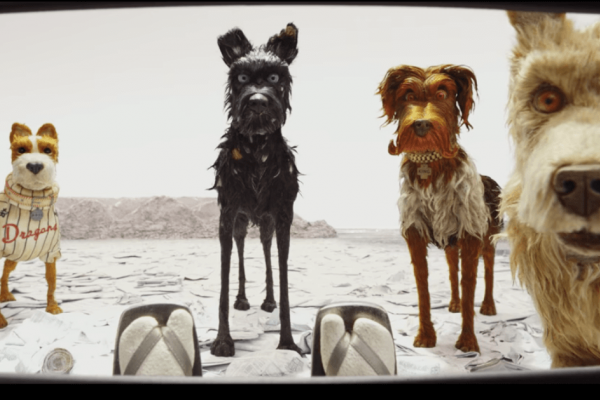To begin (cue the quirky, archival instrumental music), a few establishing shots (as told in Futura Bold title cards):
- Most people either love Wes Anderson films or hate Wes Anderson films. I love them.
- This is the third essay about a Wes Anderson film I’ve written for Sojourners in six years.
- I’ve used the words “masterpiece” or “masterful” (or both) in all three.
A few spoilers may follow.
The auteur’s latest film, Isle of Dogs, which opens today in limited release and widely later this month, is an almost giddy tour de force, another masterpiece in a cinematic oeuvre already chock-a-block with them.
It is also Anderson’s most political film to date, wherein its eerie social prescience (principal filming began in October 2016) rivals its artistic and technical virtuosity.
Known for meticulous filmmaking, his manic-yet-ever-generous attention to detail is his calling card. But in Isle of Dogs, Anderson’s ninth feature-length film, painstakingly shot using stop-motion animation, intricate puppets, and “micro-sets,” his lavish exactitude reaches its apex.
Isle of Dogs is visually spectacular. I’ve never seen anything like it — although Anderson’s 2009 stop-motion Fantastic Mr. Fox is similar if not as opulent as its canine progenitor. The tableau and sets, hand-crafted in miniature, that comprise the world of Isle of Dogs are so beautifully composed I audibly gasped during a scene in a laboratory, where beakers of various shapes, filled with jewel-toned liquids, lined a stark white wall while tiny scientists toasted their success with even tinier cups of sake.
The story, written by Anderson with oft-collaborators Roman Coppola and his cousin, Jason Schwartzman (with additional assistance from Kunichi Nomura), unfolds in the fictional Megasaki City, Japan, in the not-too-distant future. After stoking the fears of his constituents with an outbreak of “snout fever” or “dog flu,” corrupt strongman Mayor Kobayashi (who comes from a long line of historically pro-feline/anti-canine overlords) issues a fiat (executive order) exiling all city dogs to Trash Island, a toxic garbage heap off the shores of the metropolis where the ailing animals are left to fend for themselves.
Among the exiles is Spots (voiced by Liev Schreiber), the guard dog and constant companion of Kobayashi’s orphaned 12-year-old nephew and ward, Atari (voiced by newcomer Koyu Rankin), who sets off alone in his tiny Junior Turbo Prop plane to rescue his pet from Trash Island, where he crashes the aircraft and is himself rescued by a band of literal underdogs (voiced by an august cast of actors including F. Murray Abraham, Bill Murray, Jeff Goldblum, Tilda Swinton, Bob Balaban, Harvey Keitel, Scarlett Johansson, and Edward Norton.)
Thus commences the canine/human hero’s journey that leads to an uprising not against tradition and the status quo, but against tyranny, violence, and racism (or, rather, speciesism), corporate animal-testing, anti-science populism, and Big Pharma.
The human and canine heroes of Isle of Dogs set the captive free and bring the persecuted, marginalized, maligned, and oppressed back into the fullness of beloved community, delivering them from their exile on Trash Island in a regatta of makeshift rafts fashioned from garbage by teams of eccentric rivals and loners working together.
Along the way, Anderson’s signature motifs unfold apace: Outliers find their tribes, an emotionally stunted adult male — in this case the violent stray dog turned unlikely hero Chief, voiced by Brian Cranston (a newcomer to the Anderson ensemble) — makes strides toward maturity and wholeness; and, in the absence of heroic adults, quirky adolescents step up, act courageously, and save the day.
That last motif blossoms in Isle of Dogs in a way that surpasses Anderson’s previous films. Through Atari, Tracy Walker (Greta Gerwig) the “American foreign exchange student, conspiracy theorist, and pro-dog activist,” and a small band of other student-activists and reporters from the school newspaper The Daily Manifesto, the tween heroes engage directly with political, economic, and cultural powers to bring about positive change on behalf of the marginalized and powerless — the dogs.
Their aspirations are more sophisticated than Max Fischer’s self-serving battle to save Latin classes in Rushmore or even Sam Shakusky’s endeavors to liberate his love interest from the tyranny of her parents’ (and society’s) expectations in Moonrise Kingdom.
A persistent criticism of Anderson’s work has been that it is style above substance, lacking emotional depth and, for lack of a better descriptor, soul. I don’t happen to agree with such critiques, but I will say that in Isle of Dogs it feels like the filmmaker’s perspective has … evolved.
If Generation X has any icons, surely Wes is one of them. And he, like many of us children of the ‘70s and ‘80s who came of age with nostalgia for eras and cultural touchstones we hadn’t actually experienced (hello, Woodstock, the Beat Generation, Dylan, early Stones, and the Kinks), it’s taken us a while to feel comfortable, or at least more comfortable, in our own skin.
Comfortable enough to recognize not just the cultural legitimacy but the power of those who have come after us — the Millennials, Generation Z, our own children — to accomplish what we have not. To change the world and bring about justice, even if it’s for man’s best friends.
We see this subtle shift reflected in Atari’s primary quest, which is not for safety or even justice, but to reconcile with Spots, the only sentient being that always hears him, thanks to the in-ear transmitter they both wear. He wants to be known and understood by his single source of unconditional love. Don’t we all?
There is a moral (some might even say spiritual) clarity shared by the young humans in Isle of Dogs that hasn’t been celebrated in Anderson's previous films, and that feels particularly salient right now as we watch children, led by the student-activists from Parkland, champion a national movement to demand sweeping legal and political changes to combat the rampant gun violence that plagues our nation.
In this and other ways, the melancholia that wends through most of Anderson’s films is tempered in Dogs, even as his other signatures — homage and whimsy — are in full voice, and in two languages. (Only the dogs’ barks are “translated” into English. Most of the Japanese spoken by Japanese characters in the film appears without translation or subtitles.)
From the soundtrack with music taken from the films of Akira Kurosawa and other giants of the Japanese cinema he so admires, to a character named “Assistant-Scientist Yoko-Ono” voiced by the one and only Yoko Ono herself, Frances McDormand voicing the empathetic Japanese-to-English translator, and Easter eggs left for diehard Wes-heads, such as longtime ensemble member Anjelica Huston appearing in the credits for her portrayal of “Mute Poodle,” Isle of Dogs is 100 percent, quintessential “Wes World.”
Anderson has, once again and with loving, ingenious attention to detail down to every last hair and tuft of fur, created an oasis — his inimitable version of Rankin-Bass’s Island of Misfit Toys—to amuse and inspire our collective imagination. For such a time as this.
Cue the slow-motion montage of nerdy teens and scruffy dogs walking into the sunset.
Until we meet again.
Got something to say about what you're reading? We value your feedback!







